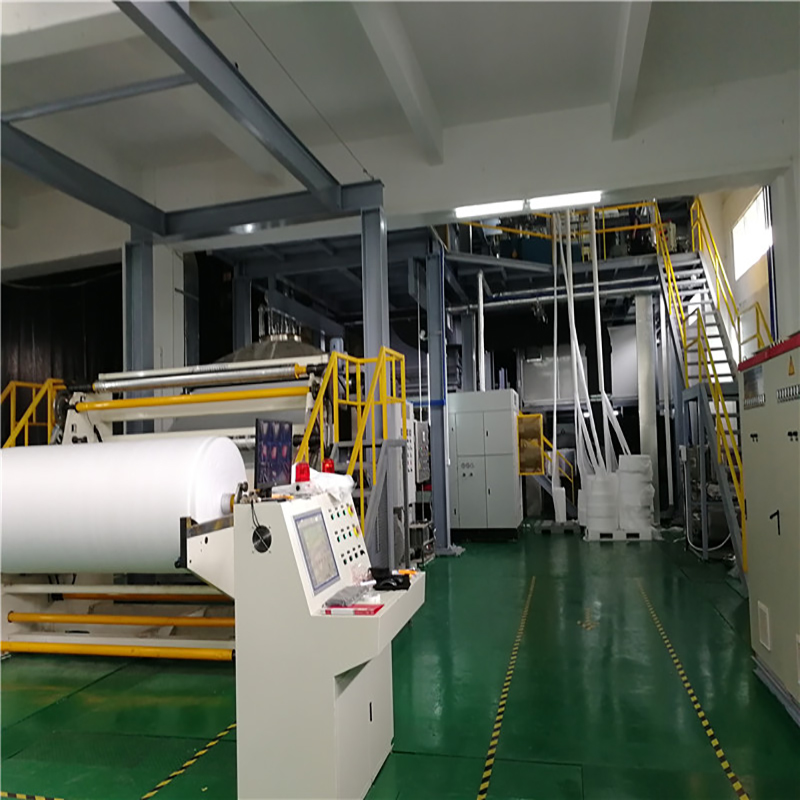Operating a PP Meltblown Non-Woven Fabric Production Line involves several safety precautions and measures to protect workers and maintain equipment integrity. Safety is of utmost importance in any industrial setting.
Here are some key precautions and measures:
Worker Safety:
- Training: Ensure that all personnel operating the production line are adequately trained in safe operation, emergency procedures, and the proper use of personal protective equipment (PPE).
- PPE: Workers should wear appropriate PPE, which may include safety goggles, hearing protection, gloves, aprons, and respiratory protection when handling chemicals or in areas with potential airborne contaminants.
- Machine Guards: Ensure that all moving parts of the production line are properly guarded to prevent accidental contact. Guards should not be removed or bypassed.
- Emergency Procedures: Establish and communicate clear emergency procedures, including protocols for handling chemical spills, fires, equipment malfunctions, and medical emergencies.
- First Aid: Make sure that first-aid supplies are readily available, and designate personnel trained in first aid or emergency response.
- Safety Signage: Post appropriate safety signage, including warnings, equipment-specific instructions, and emergency contact information.
- Safe Handling of Chemicals: If chemicals are used in the production process, ensure proper storage, labeling, and handling. Provide Material Safety Data Sheets (MSDS) for all chemicals used.
Equipment Safety:
- Regular Maintenance: Implement a maintenance schedule to regularly inspect and maintain the production line equipment. Address any malfunctions or signs of wear promptly.
- Lockout/Tagout: Establish and follow lockout/tagout procedures to ensure that equipment is de-energized and cannot be started during maintenance or repair work.
- Fire Safety: Maintain adequate fire safety measures, including fire extinguishers, smoke detectors, and sprinkler systems, in compliance with local regulations.
- Electrical Safety: Ensure that all electrical components and wiring are up to code and inspected regularly to prevent electrical hazards.
- Machine Safety Features: Use machines with built-in safety features such as emergency stop buttons, interlocks, and safety sensors. Ensure that these features are functional and properly maintained.
Housekeeping and Workspace Safety:
- Cleanliness: Maintain a clean and organized workspace to reduce tripping hazards and promote overall safety.
- Ventilation: Ensure proper ventilation and exhaust systems to control air quality and prevent exposure to airborne contaminants.
- Storage: Properly store raw materials, finished products, and chemicals, following safety guidelines for hazardous substances.
Environmental Safety:
- Waste Management: Implement responsible waste management practices to dispose of waste materials and chemicals in an environmentally safe manner.
- Environmental Regulations: Comply with environmental regulations related to emissions, waste disposal, and other environmental considerations.
- Spill Response: Develop spill response procedures to handle chemical spills or leaks, including containment and cleanup measures.
Safety is an ongoing process, and it is essential to regularly review and update safety procedures and protocols. Additionally, engage workers in safety training and encourage a culture of safety awareness throughout the production facility.
How are the properties of the meltblown fabric, such as fiber diameter and basis weight, controlled and customized during the production process?
The properties of meltblown fabric, including fiber diameter and basis weight, are critical to meeting specific application requirements. Controlling and customizing these properties during the production process involves various parameters and adjustments.
Here’s how it’s done:
- Polymer Selection and Additives: The choice of polypropylene (PP) resin and any additives plays a crucial role in controlling the properties of the meltblown fabric. pp meltblown non-woven fabric production line Resin characteristics, such as melt flow rate (MFR) and molecular weight, influence fiber formation.
- Polymer Extrusion Temperature: The temperature of the extruded polymer is carefully controlled. Higher temperatures can lead to finer fibers, while lower temperatures result in coarser fibers. This parameter affects fiber diameter.
- Extrusion Rate: The rate at which polymer is extruded through the spinneret (extrusion rate) can be adjusted to control the amount of material used per unit area. A higher extrusion rate typically leads to a higher basis weight.
- Spinneret Design: The design of the spinneret, including the number and arrangement of holes, determines the number of filaments and their distribution. Customized spinneret designs are crucial for controlling both fiber diameter and basis weight.
- Airflow and Quenching: The temperature and flow rate of quench air, which cools the filaments as they are extruded, influence fiber solidification and diameter. Adjustments in quench air parameters can affect fiber quality.
- Die-to-Collector Distance: The distance between the die (spinneret) and the collector (conveyor or drum) can be adjusted. A shorter distance results in finer fibers, while a longer distance can produce coarser fibers. This parameter impacts fiber diameter.
- Calendering and Bonding: Calender rolls or other bonding methods are used to consolidate the web of meltblown fibers. The pressure and temperature during this bonding process can affect the basis weight of the fabric.
- Basis Weight Measurement: To ensure the fabric meets the specified basis weight, it is crucial to monitor and control the extrusion rate and web consolidation process. Basis weight is typically measured in grams per square meter (gsm).
- Quality Control: Implementing rigorous quality control measures, including in-line monitoring and testing, ensures that the fabric’s properties meet the desired specifications. This may involve continuous measurements of fiber diameter and basis weight.
- Feedback and Adjustments: Production lines often include feedback mechanisms that monitor key parameters. If variations are detected, the system can make real-time adjustments to maintain consistent product quality.
- Customization: Customers may have specific requirements for meltblown fabric properties, and production lines can be adjusted to meet these customizations. This may involve changing resin formulations, spinneret designs, or process settings.
By carefully adjusting these parameters, operators can control and customize meltblown fabric properties to achieve the desired fiber diameter and basis weight, making the fabric suitable for various applications, including filtration, medical, and protective materials. Regular testing and quality control checks are essential to ensure consistency and meet industry standards.
